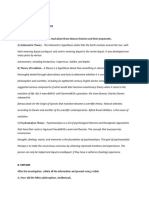0 ratings0% found this document useful (0 votes)
257 views58 - Trompenaars Cultural Dimensions
58 - Trompenaars Cultural Dimensions
Uploaded by
DominikDZThis document outlines Trompenaars' seven cultural dimensions model, which identifies key areas of cultural variation:
1) Universalism vs Particularism - Whether rules or relationships take precedence
2) Individualism vs Communitarianism - Whether people function as individuals or as part of a group
3) Specific vs Diffuse - The degree to which people get involved in each other's lives
4) Affective vs Neutral - The acceptability of displaying emotions
5) Achievement vs Ascription - Whether status is earned or given based on attributes
6) Sequential vs Synchronic time - Whether time is viewed as linear or cyclical
7) Internal vs External control - The degree of control
Copyright:
© All Rights Reserved
Available Formats
Download as PDF, TXT or read online from Scribd
58 - Trompenaars Cultural Dimensions
58 - Trompenaars Cultural Dimensions
Uploaded by
DominikDZ0 ratings0% found this document useful (0 votes)
257 views4 pagesThis document outlines Trompenaars' seven cultural dimensions model, which identifies key areas of cultural variation:
1) Universalism vs Particularism - Whether rules or relationships take precedence
2) Individualism vs Communitarianism - Whether people function as individuals or as part of a group
3) Specific vs Diffuse - The degree to which people get involved in each other's lives
4) Affective vs Neutral - The acceptability of displaying emotions
5) Achievement vs Ascription - Whether status is earned or given based on attributes
6) Sequential vs Synchronic time - Whether time is viewed as linear or cyclical
7) Internal vs External control - The degree of control
Original Title
58_Trompenaars Cultural Dimensions
Copyright
© © All Rights Reserved
Available Formats
PDF, TXT or read online from Scribd
Share this document
Did you find this document useful?
Is this content inappropriate?
This document outlines Trompenaars' seven cultural dimensions model, which identifies key areas of cultural variation:
1) Universalism vs Particularism - Whether rules or relationships take precedence
2) Individualism vs Communitarianism - Whether people function as individuals or as part of a group
3) Specific vs Diffuse - The degree to which people get involved in each other's lives
4) Affective vs Neutral - The acceptability of displaying emotions
5) Achievement vs Ascription - Whether status is earned or given based on attributes
6) Sequential vs Synchronic time - Whether time is viewed as linear or cyclical
7) Internal vs External control - The degree of control
Copyright:
© All Rights Reserved
Available Formats
Download as PDF, TXT or read online from Scribd
Download as pdf or txt
0 ratings0% found this document useful (0 votes)
257 views4 pages58 - Trompenaars Cultural Dimensions
58 - Trompenaars Cultural Dimensions
Uploaded by
DominikDZThis document outlines Trompenaars' seven cultural dimensions model, which identifies key areas of cultural variation:
1) Universalism vs Particularism - Whether rules or relationships take precedence
2) Individualism vs Communitarianism - Whether people function as individuals or as part of a group
3) Specific vs Diffuse - The degree to which people get involved in each other's lives
4) Affective vs Neutral - The acceptability of displaying emotions
5) Achievement vs Ascription - Whether status is earned or given based on attributes
6) Sequential vs Synchronic time - Whether time is viewed as linear or cyclical
7) Internal vs External control - The degree of control
Copyright:
© All Rights Reserved
Available Formats
Download as PDF, TXT or read online from Scribd
Download as pdf or txt
You are on page 1of 4
Trompenaars Cultural Dimensions
Trompenaars work is based on seven cultural dimensions. According to Trompenaars:
Every culture distinguishes itself from others by the specific solutions it chooses to certain
problems which reveal themselves as dilemmas. It is convenient to look at these problems under
three headings: those which arise from our relationships with other people; those which come
from the passage of time; and those which relate to the environment.
Universalism vs Particularism
What is more important - rules or relationships?
People in universalistic cultures share the belief that general rules, codes, values and
standards take precedence over particular needs and claims of friends and relations. In a
universalistic society, the rules apply equally to the whole universe of members. Any
exception weakens the rule.
For example: the rule that you should bear truthful witness in a court of law, or give your
honest judgment to the insurance company concerning a payment it is about to make to
you, is more important here than particular ties of friendship or family. It isnt that in
universalistic cultures, particular ties are completely unimportant. But the universal truth, the
law, is considered logically more significant than these relationships.
Particularistic cultures see the ideal culture in terms of human friendship, extraordinary
achievement and situations; and in intimate relationships. The spirit of the law is deemed
more important than the letter of the law.
Obviously there are rules and laws in particularistic cultures; but these merely codify here
how people relate to each other. Rules are needed - if only to be able to make exceptions
to them for particular cases - but we need to be able to count on our friends.
Individualism vs Communitarianism
Do we function in a group or as an individual?
Each one of us is born alone. In a predominantly individualistic culture people place the
individual before the community. Individual happiness, fulfillment, and welfare set the pace.
People are expected to decide matters largely on their own and to take care primarily of
themselves and their immediate family. In a particularistic culture, the quality of life for all
members of society is seen as directly dependent on opportunities for individual freedom
and development. The community is judged by the extent to which it serves the interest of
individual members.
Each one of us is born into a family, a neighborhood, a community, which existed before we
did, and will continue after we die. In a predominantly communitarian culture people place
the community before the individual. It is the responsibility of the individual to act in ways
which serve society. By doing so, individual needs will be taken care of naturally.
The quality of life for the individual is seen as directly dependent on the degree to which he
takes care of his fellow man, even at the cost of individual freedom. The individual is judged
by the extent to which he serves the interest of the community.
http://www.thtconsulting.com/Content/cont042.htm 2
Specific vs Diffuse
How far do we get involved?
People from specific cultures start with the elements; the specifics. First they analyze
them separately, and then they put them back together again. In specific cultures, the whole
is the sum of its parts. Each persons life is divided into many components: you can only
enter one at a time. Interactions between people are highly purposeful and well-defined.
The public sphere of specific individuals is much larger than their private sphere. People
are easily accepted into the public sphere, but it is very difficult to get into the private
sphere, since each area in which two people encounter each other is considered separate
from the other, a specific case. Specific individuals concentrate on hard facts, standards,
and contracts.
People from diffusely oriented cultures start with the whole and see each element in
perspective of the total. All elements are related to each other. These relationships are
more important than each separate element; so the whole is more than just the sum of its
elements.
Diffuse individuals have a large private sphere and a small public one. Newcomers are not
easily accepted into either. But once they have been accepted, they are admitted into all
layers of the individuals life. A friend is a friend in all respects: tennis, cooking, work, etc.
The various roles someone might play in your life are not separated.
Qualities cherished by diffuse cultures include style, demeanor, ambiance, trust,
understanding, etc.
Affective vs Neutral
How far do we get involved?
In an affective culture people do not object to a display of emotions. It isnt considered
necessary to hide feelings and to keep them inside. Affective cultures may interpret the less
explicit signals of a neutral culture as less important. They may be ignored or even go
unnoticed.
In a neutral culture people are taught that it is incorrect to show ones feelings overtly. This
doesnt mean they do not have feelings, it just means that the degree to which feeling may
become manifest is limited. They accept and are aware of feelings, but are in control of
them. Neutral cultures may think the louder signals of an affective culture too excited, and
over-emotional. In neutral cultures, showing too much emotion may erode your power to
interest people.
http://www.thtconsulting.com/Content/cont042.htm 3
Achievement vs Ascription
Do we have to prove ourselves to receive status or is it given to us?
Achieved status refers to what an individual does and has accomplished. In achievement-
oriented cultures, individuals derive their status from what they have accomplished. A
person with achieved status has to prove what he is worth over and over again: status is
accorded on the basis of his actions.
Ascribed status refers to what a person is and how others relate to his or her position in
the community, in society or in an organization. In an ascriptive society, individuals derive
their status from birth, age, gender or wealth. A person with ascribed status does not have
to achieve to retain his status: it is accorded to him on the basis of his being.
Sequential vs Synchronic cultures
Do we do things one at a time or several things at once?
Every culture has developed its own response to time. The time orientation dimension has
two aspects: the relative importance cultures give to the past, present, and future, and their
approach to structuring time. Time can be structured in two ways. In one approach time
moves forward, second by second, minute by minute, hour by hour in a straight line. This is
called sequentialism. In another approach time moves round in cycles: of minutes, hours,
days, years. We call this synchronism.
People structuring time sequentially tend to do one thing at a time. They view time as a
narrow line of distinct, consecutive segments. Sequential people view time as tangible and
divisible. They strongly prefer planning and keeping to plans once they have been made.
Time commitments are taken seriously. Staying on schedule is a must.
People structuring time synchronically usually do several things at a time. To them, time is
a wide ribbon, allowing many things to take place simultaneously. Time is flexible and
intangible. Time commitments are desirable rather than absolute. Plans are easily changed.
Synchronic people especially value the satisfactory completion of interactions with others.
Promptness depends on the type of relationship.
Past-oriented cultures
If a culture is predominantly oriented towards the past, the future is seen as a
repetition of past experiences. Respect for ancestors and collective historical
experiences are characteristic of a past-oriented culture.
Present-oriented cultures
A predominantly present-oriented culture will not attach much value to common past
experiences nor to future prospects. Day-by-day experiences tend to direct peoples
life.
Future-oriented cultures
In a future-oriented culture most human activities are directed toward future
prospects. Generally, the past is not considered to be vitally significant to a future
state of affairs. Planning constitutes a major activity in future-oriented cultures.
http://www.thtconsulting.com/Content/cont042.htm 4
Internal vs External
Do we control our environment or work with it ?
Relations with Nature
Every culture has developed an attitude towards the natural environment. Survival has
meant acting with or against nature. The way we relate to our environment is linked to the
way we seek to have control over our own lives and over our destiny or fate.
Internalistic people have a mechanistic view of nature. They see nature as a complex
machine and machines can be controlled if you have the right expertise. Internalistic people
do not believe in luck or predestination. They are inner-directed - ones personal resolution
is the starting point for every action. You can live the life you want to live if you take
advantage of the opportunities. Man can dominate nature - if he makes the effort.
Externalistic people have a more organic view of nature. Mankind is one of natures
forces, so should operate in harmony with the environment. Man should subjugate to nature
and go along with its forces. Externalistic people do not believe that they can shape their
own destiny. Nature moves in mysterious ways, and therefore you never know what will
happen to you. The actions of externalistic people are outer-directed - adapted to external
circumstances
You might also like
- Thai Politics, Economy and Foreign PolicyDocument27 pagesThai Politics, Economy and Foreign PolicyHario Akhmad RifaiNo ratings yet
- Despatch From Cabinet - 25th February, 2021Document7 pagesDespatch From Cabinet - 25th February, 2021State House Kenya50% (2)
- Cleanliness Is Next To GodlinessDocument2 pagesCleanliness Is Next To GodlinessShyam AnandNo ratings yet
- Values & Principles of EthicsDocument24 pagesValues & Principles of EthicsTheresa BreadNo ratings yet
- Module 5Document31 pagesModule 5Francisco Cuello100% (3)
- Important of SportsDocument1 pageImportant of SportsKa Siang GohNo ratings yet
- MalnutritionDocument12 pagesMalnutritionSi R100% (1)
- Reaction Paper On "How Culture Affects Our Personality"Document1 pageReaction Paper On "How Culture Affects Our Personality"Mariz Bautista100% (1)
- Answer The Following Questions:: Melting PotDocument2 pagesAnswer The Following Questions:: Melting PotAzzmarie Nicole LopezNo ratings yet
- Imelda Pilapil - Wikipilipinas: The Hip 'N Free Philippine EncyclopediaDocument2 pagesImelda Pilapil - Wikipilipinas: The Hip 'N Free Philippine EncyclopediaJoy SedanNo ratings yet
- Human Population Growth PDFDocument21 pagesHuman Population Growth PDFnawaldabombNo ratings yet
- Example Essay On MaterialismDocument2 pagesExample Essay On MaterialismeewrwrwrNo ratings yet
- Global Citizenship EssayDocument5 pagesGlobal Citizenship Essayapi-303090476No ratings yet
- Dysthanasia, Euthanasia and Orthotanasia PDFDocument4 pagesDysthanasia, Euthanasia and Orthotanasia PDFpaula beltranNo ratings yet
- Organization CultureDocument5 pagesOrganization CultureKamil FarooqNo ratings yet
- Full Notes Gss5 EthicsDocument13 pagesFull Notes Gss5 EthicsVincent Miguel BastieroNo ratings yet
- College of Teacher Education: Mariano Marcos State UniversityDocument12 pagesCollege of Teacher Education: Mariano Marcos State UniversityJazzel Jane A UlepNo ratings yet
- Oil Pollution in Groundwater of Jaffna RegionDocument38 pagesOil Pollution in Groundwater of Jaffna RegionKanaga GnanaNo ratings yet
- How Do You Think Overconsumptions Puts The Planet and Society at Risk?Document1 pageHow Do You Think Overconsumptions Puts The Planet and Society at Risk?Anthony GiliNo ratings yet
- Aristotle Good Life GargarDocument1 pageAristotle Good Life GargarSarah Jean GargarNo ratings yet
- Population Focused Approach and CHN InterventionsDocument9 pagesPopulation Focused Approach and CHN InterventionsGil Platon SorianoNo ratings yet
- Global Demography: Group 10Document36 pagesGlobal Demography: Group 10jherlynNo ratings yet
- Religion and Globalization New Possibilities Furthering ChallengesDocument11 pagesReligion and Globalization New Possibilities Furthering ChallengesFe CanoyNo ratings yet
- Filipino Gen Z As Emerging Voters - Apathetic, Uncritical, Social Media DependentDocument6 pagesFilipino Gen Z As Emerging Voters - Apathetic, Uncritical, Social Media DependentThug ProNo ratings yet
- Reaction PaperDocument2 pagesReaction Papercherry jean romanoNo ratings yet
- Script Ge3Document2 pagesScript Ge3Cedric Jon SudarioNo ratings yet
- ECOLOGY Handouts November 2016Document14 pagesECOLOGY Handouts November 2016Eljunem FelixNo ratings yet
- ETHICS - Reflection PaperDocument2 pagesETHICS - Reflection PaperErika Nell LachicaNo ratings yet
- The Globalization of Religion: Members: Apalacio, Apares, Baylosis, Batistis, Buca, Cartilla, CamposDocument17 pagesThe Globalization of Religion: Members: Apalacio, Apares, Baylosis, Batistis, Buca, Cartilla, CamposMechelle Mae VercideNo ratings yet
- Cause Effect Essay-Marine PollutionDocument2 pagesCause Effect Essay-Marine PollutionEMA DWI ARSITANo ratings yet
- Diasanta, Jirahmae M. - Module 3Document3 pagesDiasanta, Jirahmae M. - Module 3JIrahmae DiasantaNo ratings yet
- What Is MicrobiologyDocument13 pagesWhat Is MicrobiologyShifa RazaNo ratings yet
- Governance & Globalization in The Context of Ldcs and Nepal: ProfDocument60 pagesGovernance & Globalization in The Context of Ldcs and Nepal: Profnischal baaniyaNo ratings yet
- Civil Society OrganizationsDocument4 pagesCivil Society Organizationskevin100% (1)
- Primary Sources and Secondary Sources of Acquiring COVID-19 InformationDocument1 pagePrimary Sources and Secondary Sources of Acquiring COVID-19 InformationSareno PJhēaNo ratings yet
- Tasaday, small-WPS OfficeDocument4 pagesTasaday, small-WPS OfficeChuchulate MamanaoNo ratings yet
- Lesson04 Barriers To Intercultural CommunicationDocument4 pagesLesson04 Barriers To Intercultural CommunicationPatricia Catherine UrbiztondoNo ratings yet
- Autonomy ReportDocument4 pagesAutonomy ReportWynona CaloNo ratings yet
- NCM 31 - CHN NotesDocument8 pagesNCM 31 - CHN NotesAriannaNo ratings yet
- Soc. Sci. Understanding Culture ActivityDocument4 pagesSoc. Sci. Understanding Culture Activityaomine daikiNo ratings yet
- GpeeeeDocument2 pagesGpeeeeRejill May Betaizar LlanosNo ratings yet
- THE Contemporary World: Module #6Document9 pagesTHE Contemporary World: Module #6Brian DuelaNo ratings yet
- GEN 214: Introduction To Development Studies (Section 1, 2 & 3)Document5 pagesGEN 214: Introduction To Development Studies (Section 1, 2 & 3)Saief AhmedNo ratings yet
- Ethnocentrism in Costa Rica: Repercussions On Nursing StudentsDocument21 pagesEthnocentrism in Costa Rica: Repercussions On Nursing StudentsCarlos Ernesto MoraNo ratings yet
- Religion and GlobalizationDocument11 pagesReligion and GlobalizationVicenta MaguddayaoNo ratings yet
- Difference Between Cold-Blooded and Warm-Blooded AnimalsDocument5 pagesDifference Between Cold-Blooded and Warm-Blooded AnimalsShakil AhmedNo ratings yet
- The Contemporary World: MODULE 3: Global MobilityDocument16 pagesThe Contemporary World: MODULE 3: Global MobilityJeric RepatacodoNo ratings yet
- Poor-Quality-of-Healthcare-Services IN THE PHILIPPINESDocument8 pagesPoor-Quality-of-Healthcare-Services IN THE PHILIPPINESceejay tamayoNo ratings yet
- Gecsts Module 2 Agustin, April Joy B. Bped-1B A. EngageDocument3 pagesGecsts Module 2 Agustin, April Joy B. Bped-1B A. EngageApril joy AgustinNo ratings yet
- Declaration of Martial LawDocument4 pagesDeclaration of Martial LawSantos CathyNo ratings yet
- The 4R'S Waste Management Guiding Principle: ReduceDocument4 pagesThe 4R'S Waste Management Guiding Principle: ReduceJOSHUA MADULANo ratings yet
- Ricardo G. Sigua: Kristine Joy Halili Harolyn Manansala PSYCH 1-A Joshua Kale Lozano Ray Carl GarciaDocument8 pagesRicardo G. Sigua: Kristine Joy Halili Harolyn Manansala PSYCH 1-A Joshua Kale Lozano Ray Carl GarciaDonna Rose Sanchez FegiNo ratings yet
- Globalization EssayDocument2 pagesGlobalization EssayLex PendletonNo ratings yet
- Casual Argument Essay Global Climate ChangeDocument3 pagesCasual Argument Essay Global Climate Changeapi-254356307100% (1)
- 5-Promoting Physical Activity PDFDocument8 pages5-Promoting Physical Activity PDFJhonnyNogueraNo ratings yet
- STS Act 2Document3 pagesSTS Act 2Nica HannahNo ratings yet
- Book6 The Minoritization of Indigenous PeopleDocument3 pagesBook6 The Minoritization of Indigenous PeopleTine D Catz100% (1)
- Reflection in Different ReligionDocument9 pagesReflection in Different ReligionAllyza ZorrillaNo ratings yet
- The politics of hunger: Protest, poverty and policy in England, <i>c.</i> 1750–<i>c.</i> 1840From EverandThe politics of hunger: Protest, poverty and policy in England, <i>c.</i> 1750–<i>c.</i> 1840No ratings yet
- UNIT 1.1 Farm Management As A Way To Increase Profit: Objectives of The UnitDocument13 pagesUNIT 1.1 Farm Management As A Way To Increase Profit: Objectives of The UnitMerlyn HefervezNo ratings yet
- Huddart Kennedy Et Al 2015Document17 pagesHuddart Kennedy Et Al 2015ktiiti60No ratings yet
- Chapter-1: Def of Change, Important of Change, Types of Change, Imperative ChangeforcesDocument20 pagesChapter-1: Def of Change, Important of Change, Types of Change, Imperative Changeforcespretty89No ratings yet
- CHAPTER I Project BackgroundDocument5 pagesCHAPTER I Project BackgroundAe R ONNo ratings yet
- EO SICADAmendmentDocument2 pagesEO SICADAmendmentZyreen Kate BCNo ratings yet
- Human RelationsDocument16 pagesHuman RelationsJohn Mark CarpioNo ratings yet
- The Water Management AgreementDocument14 pagesThe Water Management AgreementEdward HollettNo ratings yet
- Hydro Power Potential and Investment Prospects in Gilgit-BaltistanDocument22 pagesHydro Power Potential and Investment Prospects in Gilgit-BaltistanZakawat Hussain0% (1)
- Water Conswervation in Hotels by HabibDocument28 pagesWater Conswervation in Hotels by HabibChandrika AnchanNo ratings yet
- Essay-Frank Loyd Wright's Urban Proposal vs. Garden City ProposalDocument2 pagesEssay-Frank Loyd Wright's Urban Proposal vs. Garden City ProposalGeorgi BerryNo ratings yet
- Introduction To The Management and Regulation of The Norwegian Seaweed Industry P ('t':3) Var B Location Settimeout (Function (If (Typeof Window - Iframe 'Undefined') (B.href B.href ) ), 15000)Document2 pagesIntroduction To The Management and Regulation of The Norwegian Seaweed Industry P ('t':3) Var B Location Settimeout (Function (If (Typeof Window - Iframe 'Undefined') (B.href B.href ) ), 15000)IrhamNo ratings yet
- Water Treatment - Wikipedia, The Free EncyclopediaDocument10 pagesWater Treatment - Wikipedia, The Free EncyclopediaAshutosh PatelNo ratings yet
- Rain Water Harvesting and Artificial Recharging Along National Highways Standard Operating Procedure. On 3rd September 2019.Document5 pagesRain Water Harvesting and Artificial Recharging Along National Highways Standard Operating Procedure. On 3rd September 2019.Diganta Ray100% (1)
- Thematic Evaluation Study of ADB Support For Enhancing Governance in Its Public Sector OperationsDocument92 pagesThematic Evaluation Study of ADB Support For Enhancing Governance in Its Public Sector OperationsIndependent Evaluation at Asian Development BankNo ratings yet
- Group 7 Global CitizenshipDocument17 pagesGroup 7 Global CitizenshipRivera, Lord Angel AlagaseNo ratings yet
- Program Penyediaan Air Minum Dan Sanitasi Berbasis Masyarakat Ditinjau Dari Komunikasi Pembangunan (Studi Pada Satuan Kerja Pengembangan Sistem Air MinumDocument15 pagesProgram Penyediaan Air Minum Dan Sanitasi Berbasis Masyarakat Ditinjau Dari Komunikasi Pembangunan (Studi Pada Satuan Kerja Pengembangan Sistem Air MinumAdehikmah RavsanjaniNo ratings yet
- Asdc 2024 Public Speaking TopicsDocument2 pagesAsdc 2024 Public Speaking Topicsquintrish9No ratings yet
- Pembangkit ListrikDocument2 pagesPembangkit ListrikDede MulyamanNo ratings yet
- WINS Checklist Sample Ctto: DePedQuezonDocument2 pagesWINS Checklist Sample Ctto: DePedQuezonsammy ferrer baysa100% (1)
- (CÔ PHÍ THỊ BÍCH NGỌC) SỞ HẢI PHÒNG CHỮA FULL THI 16 - 4Document5 pages(CÔ PHÍ THỊ BÍCH NGỌC) SỞ HẢI PHÒNG CHỮA FULL THI 16 - 4creative minecraftNo ratings yet
- BowTie Risk AssessmentDocument21 pagesBowTie Risk AssessmentSofia Maan Guinto100% (1)
- Unlikely Alliances: Native Nations and White Communities Join To Defend Rural LandsDocument55 pagesUnlikely Alliances: Native Nations and White Communities Join To Defend Rural LandsUniversity of Washington Press100% (1)
- PestleDocument3 pagesPestleKrishna SahuNo ratings yet
- United Nations Convention On The Law of The Sea (UNCLOS)Document25 pagesUnited Nations Convention On The Law of The Sea (UNCLOS)Hurjae Soriano LubagNo ratings yet
- TF2-Slides ABD 14jan12Document10 pagesTF2-Slides ABD 14jan12Craig D'souzaNo ratings yet
- Groyne Field Design For No. 63 BeachDocument26 pagesGroyne Field Design For No. 63 BeachJonathanNo ratings yet
- Malawi Water Resources Decentralization and ParticipationDocument36 pagesMalawi Water Resources Decentralization and ParticipationMwabutwa100% (1)
- Human Population - Guided Viewing WorksheetDocument2 pagesHuman Population - Guided Viewing Worksheetapi-235669157No ratings yet
- There Are Three Specific Categorization Schemes To Explain What Managers DoDocument5 pagesThere Are Three Specific Categorization Schemes To Explain What Managers DoMona Sharma DudhaleNo ratings yet
- Limitations of Development Planning in Less Developed CountriesDocument2 pagesLimitations of Development Planning in Less Developed CountriesPetra Petra100% (2)

























































































